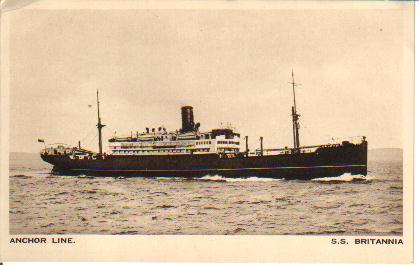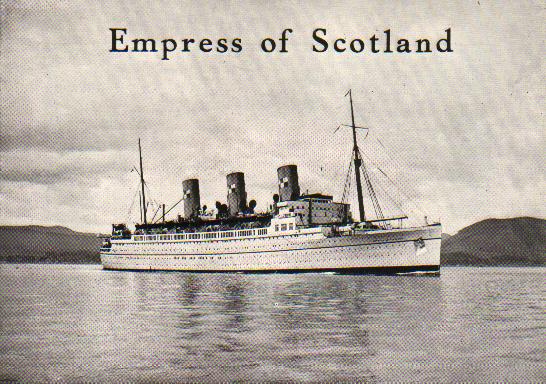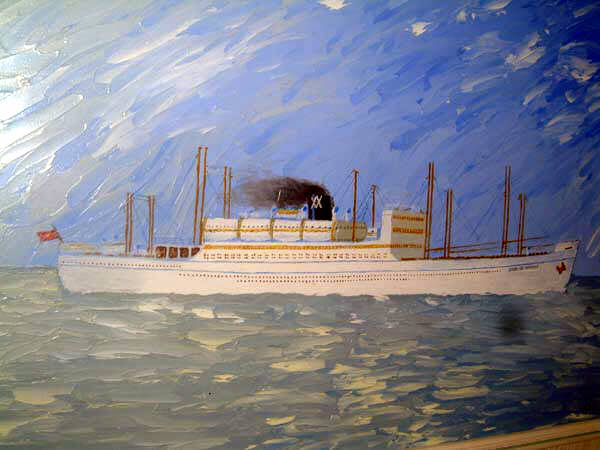The Bower & Collier Family History
Research by Colin Bower
Sinking of the SS Britannia 1941
A Personal Account by Frederick Bower
The Plan
In 2001 (quite rightly), much was made of the 60th Anniversary of the sinking of the Hood and the Bismarck. 1941 was a fateful year when countless other ships were lost including the s.s. Britannia, on which I was a passenger.
I spent the first years of the war working for London company, Electrical Installations. At the beginning of 1941, I was in Cornwall working in a small team providing power for a new station for Cable & Wireless being built in two tunnels in Porthcurno. I left the team in March to travel to Teheran to work on the University with a Senior Electrician. The plan was for me to travel to Bombay and make my way to Basra. How I was never to find out.
The Journey
My wife saw me off from Euston. As there was a war on, I did not say I was embarking for Liverpool but she told me later that she saw it on the side of the train as it left! The Britannia was used as a troop ship and there were a lot of navy, army and R.A.F. personnel on board. I was a first-class passenger.
 We sailed from Liverpool on 11th March 1941, bound for Bombay, via Freetown and Durban. The Britannia was an Anchor Line steamer of 8,799 tons and sailed in a small convoy including the City of Hong Kong and Themistocles. We had an anti-submarine escort consisting of three destroyers and an armed merchant cruiser (A.M.C.). The destroyers were stationed one ahead and one each to port and starboard of the convoy. The A.M.C. was a large passenger liner that acted as our rearguard.
We sailed from Liverpool on 11th March 1941, bound for Bombay, via Freetown and Durban. The Britannia was an Anchor Line steamer of 8,799 tons and sailed in a small convoy including the City of Hong Kong and Themistocles. We had an anti-submarine escort consisting of three destroyers and an armed merchant cruiser (A.M.C.). The destroyers were stationed one ahead and one each to port and starboard of the convoy. The A.M.C. was a large passenger liner that acted as our rearguard.
I jotted down details of my journey including my expenses in a small diary that I still have. The ship rolled quite a lot to start with and I was seasick for a few days and then was OK. One day we separated but we thought we were safe as it was thought that we travelled too fast for U-boats.
Attacked
On the fateful morning of Tuesday 25 March 1941, I was laying on my bunk cooling down after a morning bath. I then heard the sound of firing (what I knew later to be 6” guns from the German surface raider Thor). I looked out my port-hole and saw shrapnel falling into the sea. I put some clothes on quickly and made my way over to the starboard side. There was a tannoy announcement when we came under attack and we were told to keep under cover. We had a small gun at the rear of the ship. I know that the gun was knocked out and the gun crew injured. I can remember the officer Rowlandson was going to and fro taking the wounded to the first aid post. I thought highly of him.
There was another announcement when we were to take to the lifeboats, some of which were damaged. Our lifeboat was the last one on the starboard side.
I inflated my lifejacket threw my overcoat into the lifeboat, climbed down and got in. In theory it was supposed to be women first, then first class then crew. In fact it was everybody for themselves. There were too many people climbing down the ladder and some of the crew were jumping overboard. I went down a rope hand over hand. When I got down into the lifeboat, I looked back and saw that my cabin mate stayed on board and he watched the lifeboat go off.
I had a notebook in my life-jacket and I discreetly did a rough sketch of the lifeboats leaving the Britannia and the Thor. I have kept the notebook to this day.
A number of people had scorched their hands and legs coming down the rope. As the lifeboat moved away, a Scot Charles Clarke who worked for Cargills in Ceylon and a doctor named Das Gupta were still hanging onto the rope and I called out to them to leave the rope and swim out. When the doctor came aboard, he started to treat the injured and I helped.
The Britannia was ablaze and the Thor came in close and fired shots below the waterline and the ship went down, bow first.
Rescue!
We rowed to get away from the Britannia. In our lifeboat our Australian Commander, Commander Spurgeon saw the Thor lower a lifeboat. He said that we should throw all items of identification and money overboard. I threw away my passport but kept my money in my trouser back pocket. It thought that it might come in useful!
The Thor made off as it feared that Royal Navy warships might have received the Britannia’s SOS.
The Commander said that we would put the sea anchor down and stay where we were to see if we were picked up. After 2 nights we put up sail. Every day the Commander addressed us to say how many miles we had done and when we would reach Freetown. (The winds and the current were against us and later Commander Spurgeon told us that he had deliberately tried to stay in the same position hoping to be located and picked up).After a day or so I suddenly remembered my overcoat, which was sodden. Before I threw it overboard I remembered that I had put an apple in one of the pockets. It was a big apple and we cut of slivers and passed them round.
After 2 days we found a waterlogged boat with 4 men in it. It suddenly tipped over and they managed to turn it over and got back in. This happened 2 or 3 times. The Commander agreed to take them on board.
The days at sea did affect some people. After a few days, one man put on his overcoat and threw himself overboard. The Commander turned about to pick him up.
We had sharks with us virtually all the time. We were scared by swarms of whales which had whacking great fins. One or two people suggested that we have a swim. They put oars across to hold onto and a couple at a time went over. We were told to be alert and looking back we must have been mad! I went in but I didn’t swim.
I learnt later that Lieut. Rowlandson was picked up off a raft by the Cabo de Hornos a Spanish vessel, and he and a French Baroness who was a passenger, persuaded the captain to continue searching. On Saturday 29 March, we saw the Cabo de Hornos lit up (which was OK as Spain had stayed independent) and put up a flare that was spotted by a lookout. We rowed towards the ship, which in turn made for our original position!
When we met up, the lifeboat was going up and down with the swell. We climbed the rope ladder but we flopped when we got on deck and had to be carried to tables. We wanted water as this had been greatly rationed in the lifeboat. They then came round with sandwiches but took them away when we had had one each! I was pleased as punch to see that the officer Rowlandson had been rescued.
 When we were rescued by the Cabo de Hornos, some people did not have much clothing on so the French Baroness raided her husband’s wardrobe to get them clothes. I went round the boat asking the survivors to sign a menu from the Cabo de Hornos, which I still have. There are about 80 signatures.
When we were rescued by the Cabo de Hornos, some people did not have much clothing on so the French Baroness raided her husband’s wardrobe to get them clothes. I went round the boat asking the survivors to sign a menu from the Cabo de Hornos, which I still have. There are about 80 signatures.
We made for Tenerife and were there a matter of hours and the forces’ personnel were interned. Strangely we had left Tenerife and were clear of the port when the ship went back and nearly crashed into the quay in so doing!
When we arrived at Cadiz, we went straight off onto a coach that was waiting. At La Linea, we crossed into Gibraltar at 11.45 p.m. and went onto the Grand Hotel in Main Street. We had not had much in the way of food since breakfast on the ship. The Hotel had laid out food and drink in jugs. I don’t know what the drink was but it was very good!
Gibraltar
I sent a telegram to my wife Doris in Beckenham from Gibraltar telling her that I had arrived OK and asked her to let my mother know. Doris and I exchanged correspondence during the 4 weeks or so that I was there.
There was not a lot to do in Gibraltar. I did go to watch some of the inter-service football matches. When the Ark Royal came in, there was a match between them and the Black Watch. I also saw the ceremony of the keys.
There wasn’t much to buy. I did buy some eggs from some women who came over from Spain. There was a row about the price but the eggs made a nice breakfast!
When I was in a shop, buying a shirt, I think it was, a man came up to me and said: “I know you don’t I?” I said words to the effect that I did not recognise him. He said that didn’t I live at 8 Locksley Street (in Limehouse, Stepney), which was true, at one time. It turned out that he had lodged next door and though we had never spoken, he had seen me in the garden!
RAF Sunderland boats were stationed at Gibraltar. One day there was a bad storm and when I went down to the sea, the planes had been blown on their ends.
There was a story going round that there were two big ships coming. Not very good security!
Home
Charles Clarke, the Scot, and Doctor Das Gupta got on a boat going south.
 On 8 May , two large ships arrived at Gibraltar; one was the Empress of Japan (which later was renamed Empress of Scotland), the other was the Monarch of Bermuda.
On 8 May , two large ships arrived at Gibraltar; one was the Empress of Japan (which later was renamed Empress of Scotland), the other was the Monarch of Bermuda.
A message was telephoned to the Grand Hotel that they had a boat for us and we should make our way to the pierhead by 4 o’clock I think it was. We did not have a lot of time so I dashed out to the shops and bought some oranges, and some stockings. I went on the Empress of Japan and we sailed that night in convoy with Monarch of Bermuda and two destroyers (Convoy Number CF001/1 bound for the Clyde).
When I went down to breakfast, there were 6 at our table. We made our introductions and one of the others said that he had picked up our SOS. (which surprised me as I had understood that the Thor had knocked out our aerial and our SOS messages hadn’t got out).
On the next day we were shocked to see that our destroyers’ escort had left us. On the following morning when we went on deck, we were amazed to see that we had a new escort: the Repulse (battle cruiser), the Argus (aircraft carrier), two cruisers and 4 destroyers and wondered why we had such a large escort. We arrived back at Gourock in Scotland on 15 May.
Looking Back
I later found out that my wife had got a letter from the boss of Electrical Installations that my ship had been sunk but I was OK and would continue my journey! I got a new passport when I got back.
My understanding is that the Senior Electrician who I was to work with did get to Teheran but the job did not get started. Later the job came up again and Electrical Installations sent someone else. When I complained I was told that there was a place for me on a big job in Malta but I did not get out there either! I was a young electrician then and I wanted more experience.
By the time that I had returned, the news of the sinking the Britannia had been released and I kept the newspaper reports. Since then I have looked out for books about the Britannia and the Thor, from which I learnt that survivors from other lifeboats were picked up by other vessels and one lifeboat had a torrid time making it to Brazil.
I felt unwell when I got to Gibraltar (with what turned out to be a duodenal ulcer). Dr Das Gupta told me to see a doctor on my return to the UK which I did. In 1942 I spent one month in Beckenham Hospital. Eventually after many years of discomfort, I could not stand it any longer and had an operation in Charing Cross Hospital in 1969.
I still think about the time when someone suggested that I go up on deck and found the large Royal Navy escort alongside the Empress of Japan. I have since found out that the battleship Bismarck sailed for the Denmark Straits on 18 May, three days after we arrived in Scotland! If it hadn’t been for delays in the Bismarck completing its trials, it would have been at sea 14 days earlier. It makes you wonder what might have happened to us.
 I have always been grateful to Commander S.Spurgeon R.A.N. (as he was then) who kept us motivated in our lifeboat, the Captain and crew of the Cabo de Hornos who searched for and looked after us and Lieut. A.H. Rowlandson R.N. (his rank in 1941) and the French Baroness Des Pres who persuaded the Captain to carry out the searches. I painted a picture of the Cabo de Hornos which still has pride of place in my hall.
I have always been grateful to Commander S.Spurgeon R.A.N. (as he was then) who kept us motivated in our lifeboat, the Captain and crew of the Cabo de Hornos who searched for and looked after us and Lieut. A.H. Rowlandson R.N. (his rank in 1941) and the French Baroness Des Pres who persuaded the Captain to carry out the searches. I painted a picture of the Cabo de Hornos which still has pride of place in my hall.
When I look back, there are a number of memories come to mind. When the Thor sailed off there was this terrible, terrible feeling of looking out over an ocean with nothing in sight.
I can remember in early 1941 going into the village hall in Porthcurno and watching a war film where the boat was sunk and they took to the lifeboats…and this was before I set out! The 29th of March has always been a day etched in my memory as the day in 1941 when the survivors in our lifeboat were picked up by the Cabo de Hornos ( a day not unimportant to my son Colin (born in 1944!) who has typed up these notes!)
Footnote:
My son Colin looked up voyage record cards at London's Guildhall Library and found that the City of HongKong and Themistocles arrived safely.
A war loss record card summarises the following information from the Admiralty and Lloyds List:
- Britannia - attacked by raider in 7.24N 24.3W Mar 25, 1941 at 7.30 a.m. & sank
- 63 survivors - picked up by steamer Bachi in 8.9N 25.13 a.m. Mar 26
- Cabo de Hornos - picked up a further 77 in 7.50N 25.56W
- 1 crew - picked up from raft and is p.o.w. in Germany
- Crew........203...122 Missing
- Passengers 281...127 Missing
- Receiver of Wreck: 118 crew, 123 passengers lost
He also found another book in my bookcase: The Secret Raiders by David Woodward and has extracted some of the content in an Appendix.
Frederick Bower (age 94)
February 2005
Links to:
Britannia Index
